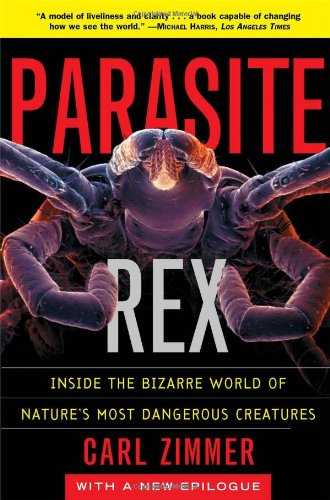I readParasite RexbyCarl ZimmeronJan 5th, 2015
★★★★★
par·a·site
an organism that lives in or on another organism (its host) and benefits by deriving nutrients at the host’s expense.
Traditionally, parasites refer to a large group of eukaryotic organisms(真核生物 ), excluding fungus, it does not include the prokaryotic microorganisms(原核生物 ), such as bacteria; or virus. The parasites are known thousand years ago by Greeks, parasitos literally means “beside food”. However, the study of the parasites is largely overseen due to that:
- the parasites are regarded as the evolution cowards which give up the freedom and all the adaptive traits for the exchange of food, shelter and reproducing offspring.
- it is hard to trace the journeys of parasites during their life cycles, and there are no fossil records to backtrack the evolution either.
The puppet master
On the contrary, the parasites are not dead end in the evolution, they have evolved to sophisticated creatures and highly adaptive to the host’s internal environment; they are also capable to fool, manipulate the host like a puppet master.
Using the Plasmodium(疟原虫) as an example. The Plasmodium attacks red blood cell and cause malaria (疟疾) which kills 584k people in 2012 estimated by WHO. The red blood cell, strictly speaking is not a cell, but a mere corpuscle: it originates from the bone marrow stem cells, and it does not carry DNA at all to leave more spaces for the oxygen. The red blood cell is so simple that it carries less protein, and does not pump out waste. Once the Plasmodium penetrates the red blood cell in 15 seconds, it first neutralize the toxic iron-rich compound of hemoglobin(血红蛋白) by molecules called hemozoin; then it rebuilds the biochemical machinery from the scratch to make the red blood cell behavior like a true cell. It also releases protein, called chapterones to keep the springiness of red blood cell’s membrane(细胞膜), so the infected red blood cell will not be recycled by the spleen. It pieces the membrane with sticky molecules to latch the blood cell to the vessel while keep dividing. Finally, the new generation of Plasmodium breaks out the cell and looks for new target.
Even though the host provides a cozy home and delicious nutrition, the parasites still need to overcome the following challenges:
- survive the host’s immune system. The host’s immune system will attack any intruders including the parasites.
- complete the chain. The parasite may hop to multiple hosts in its life cycle.
- broadcast the offspring
Survive the host’s immune system
The latches the Plasmodium uses may get the attention of the immune system. However, there are hundreds of different genes in Plasmodium DNA to make hundreds latches each with unique shape; and every now and then a parasite will switch to another gene and make new latches, a bait-and-switch tactics.
Many multiple-cell parasites can not hide inside the host’s cells. They trick the host’s immune system instead. For example, the Schistosoma(血吸虫), aka the blood fluke: its coat is made out of host’s molecules, and it manages to produce DAF(decay accelerating factor) to slice apart the complement molecules just as our cells.
There exist no vaccine for most parasites due to their dynamic evolving tricks.
Complete the chain
Many parasites have multiple intermediate hosts in the life spans, and they manage to alter the host’s behavior like puppet master. The Dicrocoelium dendriticum, or the lancet fluke starts from snails, the cercariae is wrapped with slime and coughed up by the snail. The ant eats the slime, and the parasites travel to the ants head and they do voodoo on their hosts: they drive the host upward to the top of a blade of grass in the evening, so the infected ant is likely to be devoured by a cow or some other grazer. Then the flukes make their way to the cow’s liver to live as adults.
Broadcast the offspring
Once the blood fluke lays her eggs in the vein, it manipulates the nearby macrophages(巨噬细胞) to signal TNF-(tumor necrosis factor alpha) to wrap the eggs with collagen, and carry the granuloma through the veil wall to the intestines, and eventually tumbles out of the body.
There is another stunning example: a fungus which lives inside the house flies broadcast its offspring via airborne. An infected fly lives normally for a few days, and then driven by an uncontrollable urge to find a high place and flaps wings before the fungus pushed its tendrils out of the fly’s belly. It is the perfect combination of the height, angles of wings to fire the spores into the wind.
Shaping the big picture
The parasites prevail from any criteria we could imagine:
- quantity: one host may carry thousands of parasites
- biodiversity: there are about 4000 species of mammals, but 5000 species of tapeworms so far.
- versatile: the parasites may hop to various hosts in the evolution trees which will bring the similar traits across multiple hosts
The study shows that the parasites may have profound impact on the evolution besides the current ecosystem.
The force of Red Queen hypothesis
The parasites may play an important role in the Red Queen hypothesis just like predators:
- it may impair the mobility and vigilance of the specific hosts, and give other variants evolution edges.
- The sexual production confers the species variability and a faster generational response to selection by making offspring genetically unique.
Precise surgeon
It is a much safer bet to eradicate invasive species with parasites than their predators. The predators usually have a boarder spectrum of diets, while parasites are highly specialized for specific host, like a laser-focused surgery.